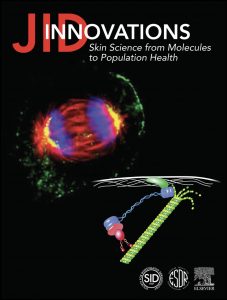Publications

Optimal Biomechanical Parameters for Measuring Sclerotic Chronic Graft-Versus-Host Disease
Authors: Laura X. Baker 1, 2, Fuyao Chen 1, 2, 3, 4, Austin Cronin 1, 2, 3, Heidi Chen 5, 6, Arved Vain 7, Madan Jagasia 5, Eric R. Tkaczyk 1, 2, 3, 5
Affiliations:
- Dermatology Service and Research Service, Tennessee Valley Healthcare System, U.S. Department of Veterans Affairs, Nashville, Tennessee, USA
- Vanderbilt Dermatology Translational Research Clinic, Vanderbilt University Medical Center, Nashville, Tennessee, USA
- Department of Biomedical Engineering, School of Engineering, Vanderbilt University, Nashville, Tennessee, USA
- Yale School of Medicine, Yale University, New Haven, Connecticut, USA
- Vanderbilt-Ingram Cancer Center, Nashville, Tennessee, USA
- Department of Biostatistics, Vanderbilt University Medical Center, Nashville, Tennessee, USA
- Institute of Physics, University of Tartu, Tartu, Estonia
Journal: JID Innovations - September 2021, Volume 1, Issue 3, Article no. 100037 (DOI: 10.1016/j.xjidi.2021.100037)
-
Field & Applications:
- Medical
- Clinical trial
- Skin / Dermatology
- Validity
Skin biomechanical parameters (dynamic stiffness, frequency, relaxation time, creep, and decrement) measured using a myotonometer (MyotonPRO) could inform the management of sclerotic disease.
To determine which biomechanical parameter(s) can accurately differentiate patients with sclerotic chronic graft-versus-host disease from post–hematopoietic cell transplant controls, 15 patients with sclerotic chronic graft-versus-host disease and 11 post–hematopoietic cell transplant controls were measured with the myotonometer on 18 anatomic sites.
Logistic regression and two machine learning algorithms (least absolute shrinkage and selection operator regression and random forest) were developed to classify subjects. In univariable analysis, frequency had the highest overfit-corrected area under the curve (0.91). Backward stepwise selection and random forest machine learning identified frequency and relaxation time as the optimal parameters for differentiating patients with sclerotic chronic graft-versus-host disease from post–hematopoietic cell transplant controls. Least absolute shrinkage and selection operator regression selected the combination of frequency and relaxation time (overfit-corrected area under the curve = 0.87). Discriminatory ability was maintained when only the sites accessible while the patient is supine (12 sites) were used.
We report the distribution of values for these highly discriminative biomechanical parameters, which could inform the assessment of disease severity in future quantitative biomechanical studies of sclerotic chronic graft-versus-host disease.
In conclusion, this study shows that a brief clinical proto- col measuring the frequency and relaxation time of patients’ skin can effectively differentiate patients with sclerotic cGVHD from post-HCT controls. A larger follow-up study is needed for model validation.


